|
|
#1
|
||||
|
||||
|
The wife and kids are at the beach giving me way too much free time. I recently picked up another ghost on the BST (thanks!) and this always gets me thinking about sheet layouts, player placements, etc.
There have been two major schools of thought. I've given each a name, not that I think they will stick.
Anyway, those were just gut calls... no fact, math, or science behind it. But after thinking about it today, my current belief is that the "important" number is not 12 nor 34; it's 17. I do believe there were 17 cards per row (as stated in the "Rule of 34") for the non-American Beauty issued cards (another thread on that in the future). So, we need to look at the issues that are a multiple of 17. And there's no better place to start than at the beginning. We already know that the Sweet Caporal 150 Factory 649 set is a multiple of 17 (34 cards), but did you know that so is Sweet Caporal 150 Factory 25 and 30. Both contain 153 cards (17 x 9). The Piedmont 150 set has 156 cards, so the seventeen theory doesn't hold water... or does it. Here are my thoughts... the first one is pretty much given fact, but I am definitely just giving (what I believe to be an educated) guess on the other two.
Last edited by t206hound; 08-12-2014 at 08:26 PM. |
|
#2
|
||||
|
||||
|
Quote:
I agree that it makes sense that the factory number would be printed in the center of the sheet, but that doesn't mean that the cards would be. It could be that the cards were aligned to the left and there was more space on the right;i.e-not enough to print a card. I'm sure Steve can give us more insight.
__________________
$co++ Forre$+ |
|
#3
|
||||
|
||||
|
Nice facts and speculation
|
|
#4
|
|||
|
|||
|
your analytical mind is what we need!
 makes a lot of sense..... I like the Plank replacement theory 
|
|
#5
|
||||
|
||||
|
Thanks Johnny. I do leave open the possibility that row size other than 17 may have been used for some issues. But this seems to make sense. I am, however, confused by Sovereign 150 (exactly 150 cards). Need to ponder that one some more.
|
|
#6
|
|||
|
|||
|
The big sheet number could be anywhere on the lower margin. That they put it centered under a card is interesting, but makes sense if as I think the plates were laid out with transfers. They'd have simply used the guidelines already there to line up the transfer. (Or, they might not have used a transfer for the factory number since there would only be one. )
I've seen some possible evidence that ALC did actually run very tight margins along at least one side of the sheet. A T201 showing the white sheet margin at the left with some indication that what was visible is all there was. (Angled cut leading into straight edges at the left, angled cut the full length on the right. ) Very tight sheet margins are usually bad practice, and it's possible they trimmed off most of the margin before folding/cutting. I find the 17/34 idea to be workable for some series or parts of series. But there are interesting exceptions. There are only around 12-13 150 only cards depending on which versions you count, and whether you discount a handful of outliers like the recently discovered Schulte 350. the 460 only group is currently at 46 cards, fitting neither scheme. The southern leaguers have 34 Hindus and 48 with other backs. Fitting both schemes. The 649 Ops do have 34 subjects, but one of them - Powers - is the only one that does not also come with a 350 back. Six superprints. Making it more complicated, looking at the 150 only group graded populations that group breaks down into two fairly well defined subgroups of 6-7 cards. (Brown, Cubs. has about twice as many Graded, which I've found to be in line with the T206 population overall, Hofers and known difficult cards are roughly twice as likely to be graded. ) So I think it's more complex than simply a sheet layout of X by Y. Each series and back I believe needs to be taken as it's own set. And then it begins to make more sense. The content of a set could have varied according to the distribution area of the brand. And we've seen this with OM and Hindu as well as the fragment of packing log that stated "other then Philadelphia area" And we know for sure that at least some subjects were reworked between the 150 and 350 series. (Conroys hat stripes) Plus, brands like Piedmont would have required far more cards than smaller brands. So a larger sheet- 48 subjects? More? for Piedmont/SC, and a smaller sheet - 17 or 34 subjects for Hindu or BL. Now add some other stuff. Like some evidence that both the 150's and 350's were reworked multiple times, and were printed from at least 3 different sets of plates. Maybe some of the 460's as well. Some faint evidence that the piedmont back plates were reworked or resurfaced at some point. Magies show flaws that I haven't seen on other Piedmont 150's. I may have missed them, but if they're out there they're also very uncommon. And some faint traces which might be the P150 scratches showing on a P350 reverse. Not unexpected- the resurfacing for reuse didn't remove much, so a bad scratch might not get removed entirely. Other stuff that's farther afield from what we have evidence for. The backs, at least Piedmont, were probably printed from stones rather than plates. It's possible the fronts and maybe some of the backs were done from plates, meaning probably different sizes. The possibility of some being produced on a two color press. Some shifts seem to come in pairs, indicating maybe a 2 color press being used at times. For Piedmont/SC --- Perhaps a web press, one that prints to a roll of stock rather than sheets. Higher production, and again, probably different size "sheets" potentially without top and bottom margins. The Hoe company made both multi color and web fed presses at the time, and were close to ALC. So it's likely the equipment was there. Steve B |
|
#7
|
||||
|
||||
|
Thanks Steve - always good to see the expert get involved in these discussions.
__________________
$co++ Forre$+ |
|
#8
|
||||
|
||||
|
Thanks Steve. I absolutely appreciate your input... you gave me great responses to sheet size questions a few months ago and your knowledge on the subject is extremely helpful to me and everyone else on the board.
A few things... and let me further say that I am absolutely guessing on this stuff. Quote:
Quote:
Quote:
They made the cut every time! I presume that the sheet layouts were potentially different for each issue. I wouldn't think that simply because these six cards appear in all series that it absolutely indicates that they were on the same sheet in each issue. Quote:
All this stuff REALLY interests me. We may never know... but I have fun hypothesizing and getting feedback. All discussion on this topic is good discussion to me! |
|
#9
|
|||
|
|||
|
Those are all excellent points.
If T206 is taken as one set, one press run, then the 150 onlys matter more. If it's looked at as a group of related sets with multiple press runs then they probably matter less. I'm leaning that way, except........ Of the 13 only two didn't make the cut in any way - Pattee and Wagner. One continued almost unchanged - Magie became Magee. Three continued the same pose - Brown(e) Brown, and Evers. Brown(e) only got a team change, the other two were entirely recolored. All the rest continued with pose changes. but with different patterns in 350 and beyond. Schulte didn't get back until the 460's So in a way nearly all of them made the cut. I have to wonder why they didn't simply continue with the same art? One of the few ideas that makes sense is that the transfers were done in blocks or strips. From original art done in strips. Strips of 6 would make some sense. So maybe early layout with 6, later with some other plan. Perhaps 6/6/5 with Wagner removed? That doesn't quite cover the imbalance in population figures, but an unbalanced arrangement would. Powers making the cut for 649op but not for 350 makes sense considering his death and unbalanced distribution. They may have sent more to Philly than other places . More indication that there was a fairly large break between 150 and 350. And another puzzle. If the 649 op sheet was 34 subjects, and was made especially for that group (I think it was, especially if it related to regional distribution) Why an overprint and not a 649 back? The sheet setup could have varied with the size of the order for cards. Between Piedmont and SC, yes it would have been a matter of 500 sheets of one 400 of the other. (Using your small comfortable numbers  ) And small orders like BL, Drum, Uzit, etc they probably did only use what was on hand, so only one sheet. Those brands I simply haven't found enough images to draw any conclusions about whether they came from one set of plates or two. ) And small orders like BL, Drum, Uzit, etc they probably did only use what was on hand, so only one sheet. Those brands I simply haven't found enough images to draw any conclusions about whether they came from one set of plates or two.But for the middle size brands It would have been a matter of balancing the setup time vs the running time. So If I have an order for lets say 100,000 Piedmonts, 1000 BL, and 50,000 Sovereign I might free up a larger press by running the sovereigns on a smaller one So I'd do the Piedmonts as (Obviously not real numbers) 1000 sheets of 100. Then swap back plates and run 10 sheets of BL. Which would take a ton of labor compared to the run time. Then I might do the Sovs as 1000 sheets of 50. That spreads the setup time across more sheets reducing the labor cost/sheet. I'm sure there's a formula for press size/quantity/labor cost But that was one of the few areas of printing they didn't involve me in. I do know that we had a small press that ran stuff in the 8 1/2x11 range a medium size one that did roughly 24" wide sheets and two 35 inch presses. And eventually a 35 inch two color press. The big ones were used for larger orders. Like a million or so bank deposit slips. The tiny one did stuff like a couple thousand business cards and a few hundred ads for a cheese business. The business cards were only 4 to a sheet. Steve B Last edited by steve B; 08-13-2014 at 12:35 PM. Reason: fixed error |
|
#10
|
|||
|
|||
|
I will start this by reminding you that in a previous thread on this topic, you agreed with me that for T206 type printing,
American Lithographic (ALC) employed a 19-inch wide press. Furthermore, your research informed us that the standard size (19" x 24") cardboard sheets were used by ALC to print these 1 7/16" x 2 5/8" cards. Here is my simulated sheet diagram of the 12 subjects in the 460-only series that I refer to as the "Exclusive 12". For a thorough explanation of this special group of 12 - T206's, check out this thread..... EXCLUSIVE 12 ...v.......................... Standard size sheet 19" wide x 24" long ...........................v 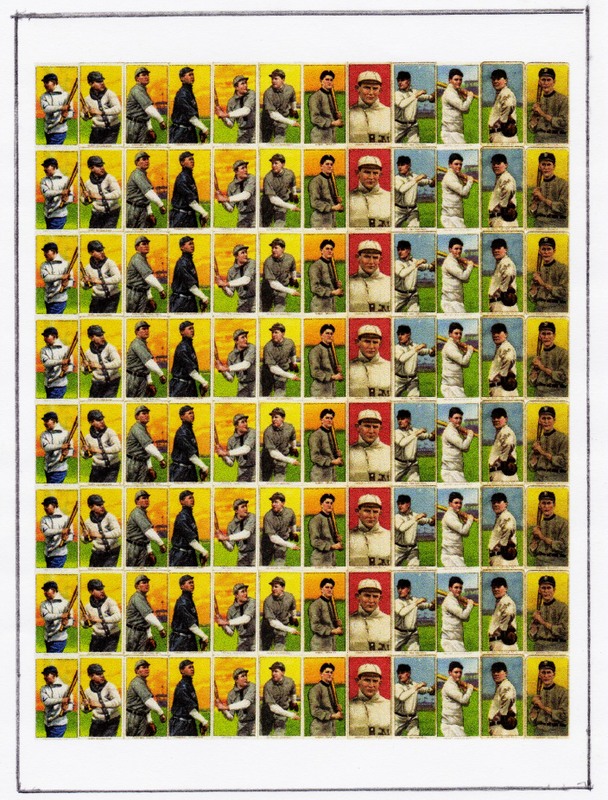 Hey guys, your mythical 34-card T206 sheet (17 across x 2 rows) is mathematically (and physically) impossible to fit on a standard sheet of cardboard whose dimensions are 19" x 24".....whichever way you try to print it Finally, there are a total of 156 subjects in the 150 series (with PIEDMONT backs). And, there are 12 subjects in the 150-only series. Therefore, 156 - 12 = 144 subjects which were printed with both the 150 & 350 backs. My math strongly suggests a factor of 12 is evident here (and throughout the White-bordered & Gold-bordered tobacco card structure). 156 subjects, or 144 subjects, or 48 subjects, or 12 subjects, are not divisible by "17" ......not in this world. T-Rex TED . |
|
#11
|
||||
|
||||
|
Ted, did you know that 144 is the twelfth number in the Fibonici series 144 and it is also twelve squared?
__________________
$co++ Forre$+ |
|
#12
|
||||
|
||||
|
Quote:
I know that you (and others) contend that there is no other sheet dimension that could have been used, but the uncut Obak sheet was 31" x 23.5" and had 21 cards per row (image from the Huggins and Scott auction listing below). It's interesting with the Obak that half the set (88) composition is represented in this sheet, which would lead you to believe a single additional sheet layout comprised the remaining cards (87). It's also interesting to me that while the entire set could have fit on a single sheet (179 card sheet layout, and 175 cards in the set) that the cards were split onto two different sheets. I'll guess it is because it allowed them to use two presses running at the same time to produce the cards. Anyway, I acknowledge that the sheets were produced by different companies on different sides of the country (I believe), but I'm letting sheer logic tell me that two tobacco card sets printed at roughly the same time could have utilized the same sheet size. Is there absolutely no way possible that T206s were printed on a sheet that exceeded 19" x 24"? 
|
|
#13
|
||||
|
||||
|
Just an random observation of mine about the Obak sheet is the vertical line in the bottom left corner.
Lines like this have appeared on the front of T206s also. Jantz |
|
#14
|
||||
|
||||
|
Great discussion. Quick note for the 350-460 series backs. There are several subgroups we see of 28 cards that combine with the 6 super prints to make 34. There are other 13+21 subgroups that are always together that also make 34. The entire 460 series cards all break down to groups that combine to 34. Some likely were done over multiple print runs with a few cards being swapped out which gives the appearance that 34 is not a constant.....but it is
 As well by taking the SC350-460 cards and grouping cards that are found together with other backs we end up with several smaller groupings. One group of 28 F42OPs shows up that do not show up with F30 backs. Even though under the OP is a F30. This sheet of 28 + 6 super prints was never released as F30 and went straight to the OP machine. Pretty cool. Fortunately a scrap sheet survived before being Over Printed and we get the 34 know examples of the yellow brown scraps. Only the 34, all but one have been found with no exceptions. This makes me happy 
__________________
T206 gallery Last edited by atx840; 08-13-2014 at 08:21 PM. Reason: more |
|
#15
|
|||
|
|||
|
Quote:
Note my emphasis of PERHAPS in your examples. I have theorized that the so-called "34 subjects" of the SWEET CAP 150 Factory #30 group were actually on a 36-card sheet. The two missing guys were Plank and Wagner (who we know were discarded). Or, if you think this theory of mine is too speculative, then consider this.....the two additional slots were filled by Double-Printing popular guys like Johnson and Matty. Quote:
early in the 20th Century. They apparently made use of their larger printing presses in the production of the OBAK series. Whereas, ALC realized, with their 6-7 color process, they achieved a higher quality yield by printing smaller sheets of cards. And, yield was an important factor when you are cranking out 10 Million cards (or more). I have seen several uncut sheets of various Non-Sports issues done by ALC....and, some are printed on smaller size (smaller than 19" x 24") sheets. My point is, that you cannot compare what SL produced and try to translate that to what ALC produced. These two printing firms operated quite differently. TED Z |
|
#16
|
|||
|
|||
|
guys!

|
|
#17
|
|||
|
|||
|
ALC did have presses with a 19" track. Specifically Hoe company number 5 presses. BUT and this is an important thing. ALC was a huge printing concern, the info about the presses comes from a diagram of one floor of the plant in an article about their conversion to electricity to run the machines.(Or use of electricity in the plant when it was new- I don't recall which it was. ) That was in Scientific American back then.
Most huge printing companies will have a variety of presses. The only places I've seen with only one size press have been either very small like someone running one of the little 10" presses in their garage. Or a place that only prints one fairly consistent item, like a newspaper or book publisher. One of the things I find fascinating is that compelling arguments can be made for Both multiples of 12 and multiples of 17. I will also say that I've seen the breakdown Chris did of the 460 series, and being at the time more in the 12 camp than the 17 I tried to use pop report numbers to break his groups. With the exception of maybe 4 cards that looked like they belonged in a different group my attempt at proving those groups wrong failed. And the very few that could have moved groups came in pairs - If one had too many graded copies for it's group it matched another group very well, AND that other group had a card that matched the other group. Neither of the swaps broke the overall pattern by requiring an unconfirmed combination. Since then I've become convinced that both 12 and 17 are correct for particular portions of some series. Some quick math based on a couple decent guesses and using Scot Readers estimates of how many might have been printed also leads me to believe that at least for the very common backs more than one press was used at a time. The numbers indicate a need for almost constant printing of Piedmont for sure. Say 100 million P350s? At 17x6 - 102 per sheet, that's 980392 sheets. Times 9 impressions/sheet is 8823529 impressions. At 800/hour = 11,029 hours. (And that doesn't count setup time and pre production, and cutting/packing) A 50 hour workweek is only 2600 hours a year. Three shifts with no downtime? 459 days  Use of a two color press would cut the time in half. Using multiple presses would make it manageable. Use of a two color press would cut the time in half. Using multiple presses would make it manageable. Another option would be a far larger sheet, perhaps made up of 4 smaller sheets. Many US stamps were printed this way. Press sheet =4 10x10 panes that were then cut apart before perforating. Steve B |
|
#18
|
|||
|
|||
|
Quote:
realized, with their 6-7 color process used to print these tobacco cards, they were able to achieve a higher YIELD of quality by printing them on smaller sheets. And, YIELD was a very important factor when you are cranking out 10's of Millions of cards in a short time span. Steve, do you agree with the above premise ? And, while it's a mystery to me that we haven't discovered any uncut sheets (or partially uncut panels) of T206's, I've seen several uncut sheets of various Non-Sports issues produced by ALC. One (or two) were printed on a 19" x 24" sheet; and, others were printed on smaller size sheets. TED Z |
|
#19
|
|||
|
|||
|
Quote:
The web presses could run much faster, but I haven't found any indication that they were for lithography. The aluminum plates came out around 1900, so it's certainly possible. Balancing quality, speed, and costs from setup time etc is the challenge. Quality is mostly up to the operator, but running faster makes it much harder. One thing all of us neglect is the possibility of very large sheets laid out in blocks that could be based on 12 or 17 subjects. Or multiple sheet arrangements - So printing both sheets that were 17 (Maybe more) Subjects AND at the same time printing sheets that were 12 subjects. I haven't seen the uncut non-sports cards, different sizes makes sense since many of those sets were 50-100 cards. If you have any links to them I think they'd be very interesting. It is odd that no uncut production baseball cards are known, when there are sheets or partial sheets of other stuff. Odder still is that the progressive proof books for cigar box labels are readily available, but I've never seen one for any card. That's probably a matter of what got saved. Steve B |
|
#20
|
|||
|
|||
|
Double post.
|
|
#21
|
|||
|
|||
|
Quote:
The following simulated 96-card sheet of known 48 subjects from the 350 series ** is my concept of a typical ALC press run employing a 19" press to print these cards on a 19" x 24" sheet of cardboard. 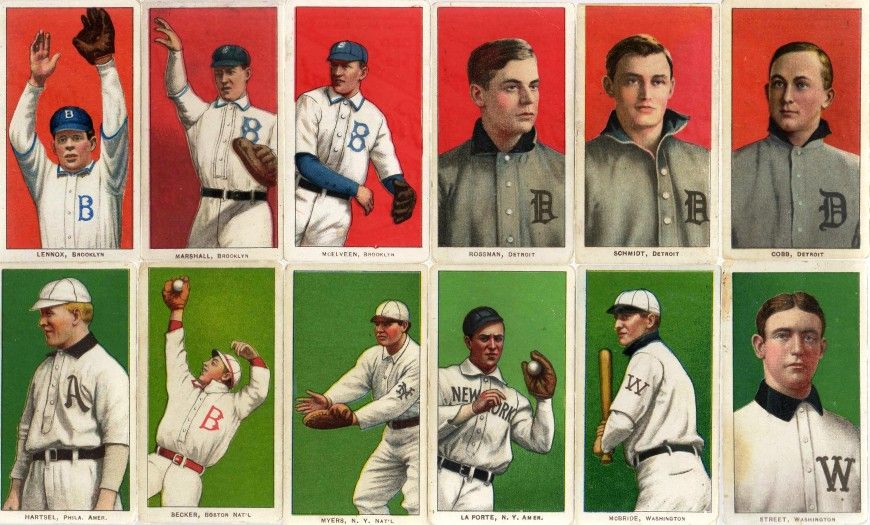  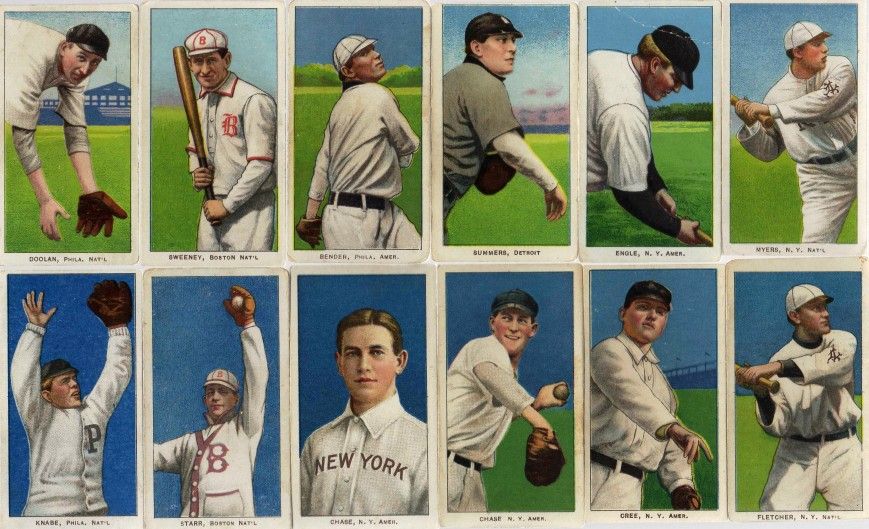 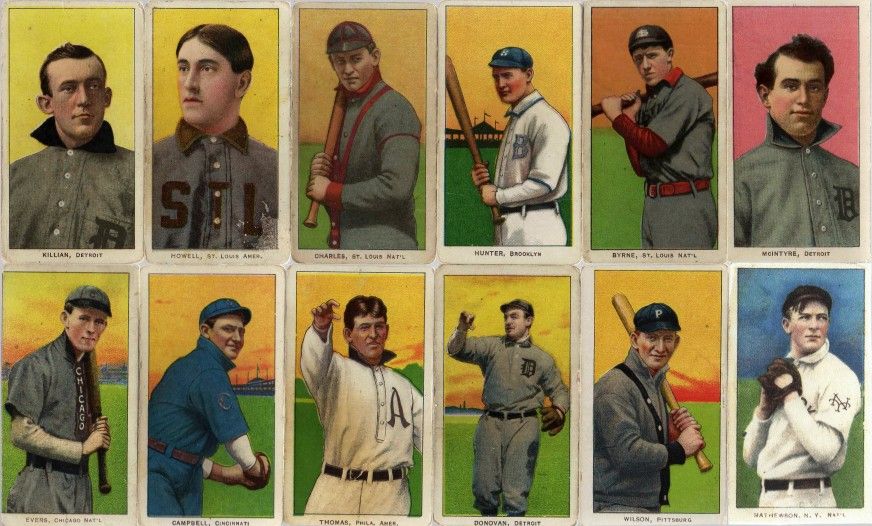     Note ** These 48 - Major League subjects are a known quantity from the 1910 COUPON issue. Their arrangement is arbitrary, but I firmly believe these 48 were printed together on the same sheet. I show them Double-Printed in order to completely fill-out the sheet. If these 96 cards do not display on your screen as a 12 x 9 arrangement, diminish the display to obtain the desired configuration. TED Z . |
|
#22
|
||||
|
||||
|
Quote:
On (at least one instance of) a Sweet Caporal 350 Factory 30 sheet:
Last edited by t206hound; 08-14-2014 at 12:55 PM. |
|
#23
|
||||
|
||||
|
Assuming that sheet layouts did not change during the piedmont 350 run (which may be totally invalid statement), you could have had this (number of rows is insignificant... alignment is what's being demonstrated):

Last edited by t206hound; 08-14-2014 at 01:12 PM. |
|
#24
|
|||
|
|||
|
I arranged this 48 subject sheet some years ago before any top/bottom data was reported. And as I stated......
Note ** These 48 - Major League subjects are a known quantity from the 1910 COUPON issue. Their arrangement is arbitrary, but I firmly believe these 48 were printed together on the same sheet. I show them Double-Printed in order to completely fill-out the sheet. If these 96 cards do not display on your screen as a 12 x 9 arrangement, diminish the display to obtain the desired configuration. So, I don't understand your comments......as, the following 9 subjects are on this sheet...... Thomas and Rossman McBride and Rossman Matty McIntyre and Danny Hoffman Hartsel and Wilson AND, I'll will add the red Cobb adjacent to Chance (yellow portrait)....as I have personally seen this combo. These subjects were printed on a different sheet (we are aware that ALC would switch around various subjects during press runs). McElveen and Dygert Stephens and Rossman Stephens and Hoblitzell Jackson and Danny Hoffman TED Z . |
|
#25
|
||||
|
||||
|
Quote:
If these 48 were printed together on the same sheet, then how could the Jackson, Stephens and Dygert cards also be on the same sheet (since they are known to be adjacent to cards in your list of 48)? Last edited by t206hound; 08-14-2014 at 01:35 PM. |
|
#26
|
|||
|
|||
|
Quote:
This is not new news, it has been previously discussed. The arrangement of the 48 subjects that I have displayed here is by no means a singular grouping of these subjects. The 6 super-prints certainly exemplify this fact. They are repeated on subsequent series sheets (e.g. they are included again in the 66-subject Sovereign apple green sheet, also, T213, T214, T215 issues). TED Z . |
|
#27
|
||||
|
||||
|
Quote:
[Edited] Just so that I make sure that we are discussing the same thing... I fully understand that between different series P350 vs S460 (superprints for example) that the layouts were different. Are you are saying that within a series (Piedmont 350 in this instance) that the layouts did or did not change? Last edited by t206hound; 08-15-2014 at 01:29 PM. |
|
#28
|
||||
|
||||
|
Curious as to the answer to my questions...
Last edited by t206hound; 08-15-2014 at 01:31 PM. |
|
#29
|
||||
|
||||
|
Still waiting...
Are you are saying that within a series (Piedmont 350 in this instance) that the layouts did or did not change? If you believe they did not change, then it's been demonstrated that there are other cards adjacent to those that you say appeared together and therefore your assertion is incorrect. If you believe that they did change, then how can you assert beyond a reasonable doubt that they ever appeared together on a single sheet? Last edited by t206hound; 08-16-2014 at 12:41 PM. |
|
#30
|
||||
|
||||
|
I bought two new brands of popcorn last night - one for each line of reasoning. Also picked up a case of Redhook pumpkin porter, which I highly recommend.
Sent from my SM-G730V using Tapatalk
__________________
$co++ Forre$+ |
|
#31
|
|||
|
|||
|
You'll need stronger stuff than pumpkin porter if you expect to understand Sheet layouts - Maybe a Belgian triple or ten
 If it's just the entertainment, the pumpkin porter is an excellent choice. Steve B |
|
#32
|
||||
|
||||
|
Well, my beer is gone. I waited all weekend and no discussion.
|
|
#33
|
||||
|
||||
|
It is all good information but the discussion points, from what I can remember, have not changed.
Sent from my SM-G730V using Tapatalk
__________________
$co++ Forre$+ |
|
#34
|
|||
|
|||
|
Quote:
Quote:
Man, you are one hyper dude ! FYI....we were away in Cape May since Friday for some Sun, Surf & Fun. Anyhow, there is really nothing more that I can add that will convince you that your "17" (or 34) myth is not the way ALC printed these cards. I have tried to explain the basis for the 48-subject arrangement that I posted.....but, it's either not registering, or you just do not understand where I'm coming from. TED Z . |
|
#35
|
||||
|
||||
|
Quote:
My question still stands as it relates to this post: Quote:
So far, your theory holds with your 48 "Coupon" players appearing together twice on one sheet (Rossman, McBride, McIntyre and Hoffman). But then we have other Piedmont 350 miscuts where we see Rossman adjacent to Stephens and Jimmy Jackson under Hoffman. So now the question: How can those 48 players (from your image) be together when we know that Stephens and Jackson were on a sheet with four of them? |
|
#36
|
|||
|
|||
|
Quote:
Fine, I will start with the fact that most of us T206 "dudes" appear to agree on......that whatever the size sheet, ALC printed the fronts first. Then, these pre-printed (blank-backed) sheets were hung up to dry....then stacked awaiting for orders from the various T-brand Factory's requesting T206 cards. In the 150 Series press runs, and the 350 Series press runs, the PIEDMONT brand cards were printed 1st. PIEDMONT cards represent approx. 50 % of the total population of T206's. SWEET CAPORAL cards represent approx. 30 % of the total population of T206's. So, I present the 48 - Major League subjects from the 1910 COUPON set as an example, as it suggests to us the structure of a very plausible sheet configuration. Note, that I said 48 SUBJECTS....which means ALC may have (and most likely) Double-Printed them producing a 96-card sheet. Furthermore, the 12 - 150-only subjects....the 48 Southern Leaguers....and, my "Exclusive 12" configuration, also suggest to us of how these cards were configured. Short of these 4 examples, it is difficult to figure out how all the other T206's were configured (or arranged) on printed sheets. 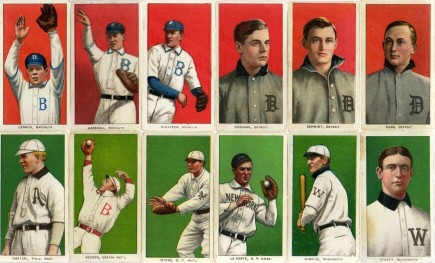 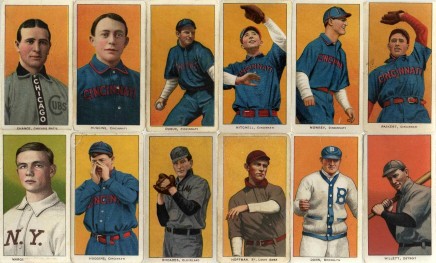 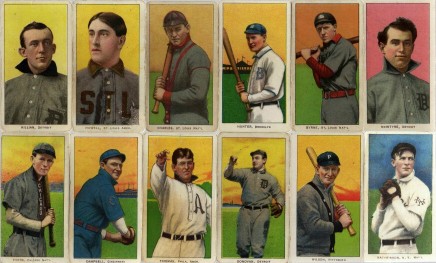 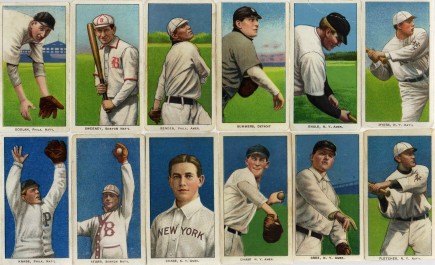             Quote:
is adjacent with subjects other than the ones on my 48-subject arrangement. Quote:
I would like to know what T-brand backs are on these two adjacent situations ? TED Z . |
|
#37
|
|||
|
|||
|
All plausible except the hanging them up to dry. I've never seen a picture of that being done even then. Maybe in an art printer, but not in a high production environment. It takes way too much time and isn't really necessary.
This next bit is where I differ from pretty much everyone else. Because of time constraints I don't see any brand being produced first. Certainly portions of a series for some brands were done before others, but Getting it done would probably have required almost constant output for the bigger brands. And most likely running various portions on different presses at the same time. For example Monday- Print yellow Tuesday -Print yellow on press 1 and possibly brown or light blue on press 2 using the yellow produced day 1(Doing brown after yellow would be odd. The yellow /browns say it may have been done, but it's not typical) I've seen a few cards that seem to have been done on a multi color press, and a very small group with a flaw that I haven't figured out. I've been researching press patents today and I'm very close to tossing nearly every assumption I've made so far. I'm thinking I really need to get up to the local printing museum to see if they have anything related to ALC or perhaps a Hoe company catalog. Steve B |
|
#38
|
|||
|
|||
|
Quote:
Well, on this account, I differ from you. The MAGIE error card and the JOE DOYLE (Nat'l error) card absolutely tell us that PIEDMONT backs were FIRST printed on the sheets of pre-printed fronts. There is no other logical explanation for the PIEDMONT-only backs on these cards and the scarcity of them. TED Z . |
|
#39
|
||||
|
||||
|
Quote:
I don't know the back of the Stephens-Rossman, but as you state, it can only be one of four (five with Coupon). I thought I was told that it was Piedmont 350, but cannot find any documentation on that. The image below is from the T206 Neighbors thread. EDITED: I have confirmed that this card has a Piedmont 350 back. Which is my point... if they switched around configurations, there's no way to know which cards comprised an entire sheet. Last edited by t206hound; 08-18-2014 at 06:57 PM. |
|
#40
|
|||
|
|||
|
Quote:
This point of your's is well taken. And, at the risk of being repetitive, the the two 48 subject examples I have presented here are windows in a specific timeline. The 1910 COUPON issue was how that arrangement was in the Spring/Summer of 1910. The 48 Southern Leaguer's arrangement was most likely very late 1909 (or early 1910) press runs since they are either OLD MILL's or PIEDMONT 350's. TED Z . |
|
#41
|
|||
|
|||
|
Quote:
"Because of time constraints I don't see any brand being produced first. Certainly portions of a series for some brands were done before others, but Getting it done would probably have required almost constant output for the bigger brands. Magie was probably very early, and yes, would have gotten Piedmont first. But there's no way of knowing whether Magie was on the very first sheet or a later sheet. If we knew which cards were with Magie then we might be able to tell. If it was with the other 150 only cards and the whole sheet was pulled and reworked. Maybe it was early. If not then there were sheets done before that one and they would have had a range of backs. The Doyle tells us nothing about the sequence of backs. The error would have been easily corrected on the press, Unlike Magie which was reworked. So the Doyle could have happened anytime during the 350 run. Scot Rs estimates of production are as high as 100 million just for Piedmont in 1910. I don't think it's realistic to think they printed all the Piedmonts them moved on to whatever was next. Even if the production number was 1/3 of that it makes no sense. What does make sense - if it was a normal sheet fed press or more likely presses. would be printing a group on multiple presses until either the order was complete or the plates wore out. Then moving on to the next sheet layout. The raw numbers make the use of one sheetfed single color press nearly impossible. 9375 hours at 1000 sheets /hour. for 100 million. 3093 hours for 33 million. A full year of 50 hour weeks is only 2600 hours. Those numbers assume a 96 card sheet. Smaller would take longer larger would be faster. Multi color presses would reduce the time a lot. As would faster presses which were usually webfed. (Printing from a large roll of paper rather than from sheets.) Steve B |
|
#42
|
||||
|
||||
|
Quote:
You are dismissing an established fact regarding ATC....PIEDMONT was ATC's "flagship" tobacco brand....and, this is the reason why 53 % T206's were printed with PIEDMONT backs (two independent large surveys both confirm this %). My guess is that American Litho first printed huge loads of PIEDMONT backed T206's and shipped them down to Factory #25 in Richmond, VA. DITTO for when ALC introduced their 350 series cards. Followed by SWEET CAPORAL backed T206's which were shipped to [Factory #25 (VA) and Factory #30 (N.Y.)]. The same surveys indicate that 28 % of the T206 population was printed with the SWEET CAPORAL brand. Quote:
series are known which were printed on the "very first" sheets. MAGEE is not one of them. Quote:
of its PIEDMONT 350 back. Quote:
I have been saying 96-card sheets (12 columns x 8 rows) for a long time now....so, I'm pleased to read here that you appear to agree. And, American Lithographic operating multiple presses simultaneously to produce millions of T206 cards sounds good to me. TED Z . Last edited by tedzan; 08-19-2014 at 02:45 PM. |
|
#43
|
||||
|
||||
|
I'll split the quotes so my comments go with the right ones
Quote:
More likely is nearly constant throughput for Piedmont and probably SC. The other brands might have been done in a single batch, especially the really hard ones like Drum and BL460. I know that goes against the established views, but barring high speed presses (Which might have been used, and almost certainly were for the pack labels) There simply wasn't enough time. Quote:
I've become positive that the 150s went to press three individual times (At least) With small changes between runs. Most likely because the plates wore out. The 350's also were done with multiple sets of plates - at least three and possibly more. And those were all slightly different form the 150's where the subject was produced for both. The question remains - Why were the 150 onlys not continued? If Magie is counted there are 13, Those fall somewhat neatly into two groups based on population numbers (for what they're worth, flawed, but the only numbers publicly available. ) That to me indicates either an uneven sheet layout or blocks of 6 by X for the transfers the layouts were probably done with. Both Wagner and MagIE were pulled, Magie to be reworked, Wagner removed entirely. Magee added to a different transfer once the rework was done, and continued. I still need to do more work on this with the numbers, but I have a feeling the odd ones like Dahlen and Lundgren may have been involved in some way as well. Quote:
What's most likely was that some sheets were printed, the mistake was recognized - Maybe by the pressman, they were in NY after all, and both Doyles played for NY teams. Approval to fix the mistake probably took a few minutes. " hey boss, this isn't the Doyle who's on the Giants." " Really? let me see." " Ok, just stone off the Natl " The very few sheets then got sent on to whatever the next step was, and eventually got Piedmont backs. Not surprising at all. As you say, they could just as easily been a stack destined for SC or any of the other backs (Doyle NY Nat'l as a BL or Drum only subject....now there's a thing to ponder.  ) )Quote:
(I think "hot " begins around 80, and "cold" starts around 20, maybe less. My wife figures "hot" as usually 90 + maybe higher. And "cold" starts around 60. Discussing this stuff is fun for me. I'm always looking for those little bits of solid proof of any part of it, and nearly always learn something new about the set and/or the players. And the perspective of someone who's handled thousands of the cards is always interesting. And I know very well that some of my ideas are well outside what's established. Frankly I'd like nothing more than to see a find of a load of ALC documents - Invoices, work orders, that sort of thing or an uncut sheet. No matter which idea it proved or disproved. Even if it proved all my ideas wrong. Steve B |
|
#44
|
||||
|
||||
|
Here is one for you Steve.
When reviewing the SLs PSA pop report totals there is some interesting data showing up. I broke the 48 SLs up into two groups, the 34 printed with OM/Pied/Hindu & the 14 printed with OM/Piedmont. The 34 group has an average ratio of .76 Piedmonts per OM printed (51%-103%) The 14 group has an average ratio of 1.6 Piedmonts per OM printed (140%-221%) Those 14 show up on average more than double with Piedmonts than the other 34 group. Based on the pop numbers it appears that those 14 SLs were printed at one point (or always) separately than the 34. 
|
|
#45
|
||||
|
||||
|
Chris, now that you are springing something new into the conversation, I am getting out the Orval Redenbacher in preparation for Ted's retort.
When my girlfriend goes shopping she buys SHIT. I buy the gourmet expensive stuff because when I eat it I want to taste it. But you know what's on my mind right now? It AIN'T the popcorn in my microwave, ...
__________________
$co++ Forre$+ |
|
#46
|
||||
|
||||
|
Quote:
https://www.youtube.com/watch?v=czb4jn5y94g#t=142
__________________
___________________ T206 Master Set:103/524 T206 HOFers: 22/76 T206 SLers: 11/48 T206 Back Run: 28/39 Desiderata You are a child of the universe, no less than the trees and the stars; you have a right to be here. And whether or not it is clear to you, no doubt the universe is unfolding as it should. With all its sham, drudgery, and broken dreams, it is still a beautiful world. Strive to be happy. |
|
#47
|
|||
|
|||
|
Quote:
In 2006, when I was working on my all-PIEDMONT set, among the last few cards I needed to complete it were a good number of the group of 34 - SL guys. So, there you are....some empirical data to support your observation on this subject of PIEDMONT vs OLD MILL SL's. TED Z |
|
#48
|
||||
|
||||
|
You know what they put on popcorn in Canada instead of butter? Cheescurds & gravy. I've seen 'em do it, man. They drown 'em in that stuff.
Thanks Ted. The pop reports likely indicate that the 14 were printed separately in the Piedmont run than the 34 group, which to me could indicate that 34 was the number used on a sheet for that series. Last edited by atx840; 08-19-2014 at 08:16 PM. |
|
#49
|
||||
|
||||
|
Quote:
__________________
$co++ Forre$+ |
|
#50
|
||||
|
||||
|
Quote:
All I can come up with is that Orval Redenbacher was two years old when the T206's were introduced. His father might have tossed him a T206 Wagner or Plank to teeth on, along with some popcorn of course.
__________________
$co++ Forre$+ |
 |
|
|
 Similar Threads
Similar Threads
|
||||
| Thread | Thread Starter | Forum | Replies | Last Post |
| Topics for discussion re: t206 Printing and errors | Clark7781 | Net54baseball Vintage (WWII & Older) Baseball Cards & New Member Introductions | 16 | 04-17-2012 09:38 PM |
| T206 Backs Discussion, Part 215,256,559 | usernamealreadytaken | Net54baseball Vintage (WWII & Older) Baseball Cards & New Member Introductions | 4 | 04-16-2010 07:31 PM |
| E cards - what size sheet to store raw? | tiger8mush | Net54baseball Vintage (WWII & Older) Baseball Cards & New Member Introductions | 2 | 04-16-2010 12:46 PM |
| T206 Printing Discussion | Archive | Net54baseball Vintage (WWII & Older) Baseball Cards & New Member Introductions | 8 | 11-21-2007 06:01 AM |
| For Discussion: Relative Values of T206 and T205 | Archive | Net54baseball Vintage (WWII & Older) Baseball Cards & New Member Introductions | 3 | 06-02-2006 09:57 AM |